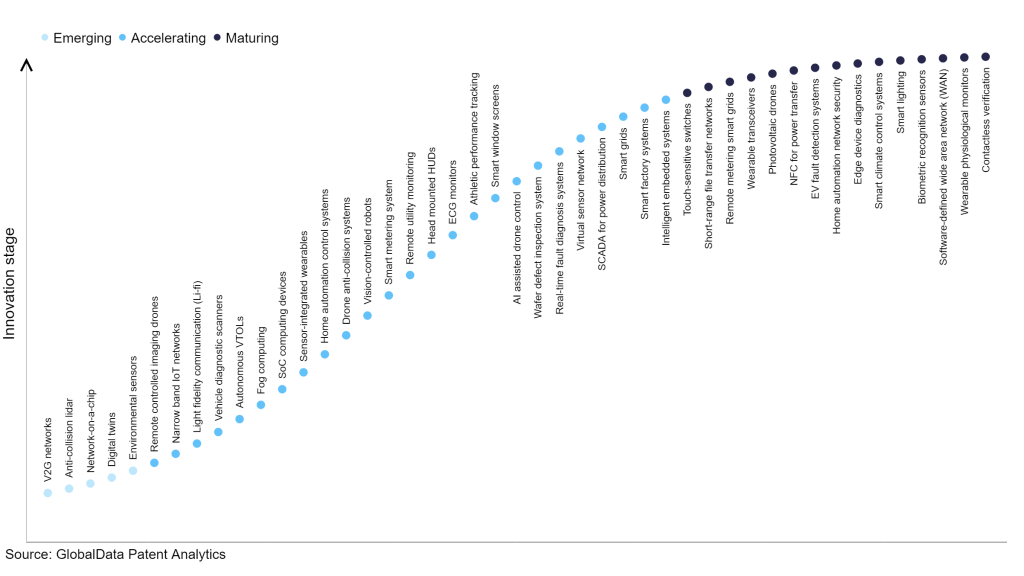The technology industry continues to be a hotbed of innovation, with activity driven by heightened connectivity and advanced wireless communication systems, digital transformation across industries, the demand for smart home solutions, increasing integration of artificial intelligence (AI) and machine learning, and growing importance of technologies such as intrusion detection and prevention systems (IDS/IPS), firewalls and routers, two-factor authentication, and biometric authentication. Home automation network security systems use secure communication protocols such as transport layer security (TLS) and secure shell (SSH) to ensure encrypted and secure communication between devices and the home automation network. In the last three years alone, there have been over 3.6 million patents filed and granted in the technology industry, according to GlobalData’s report on Innovation in Internet of Things: Home automation network security. Buy the report here.

Access deeper industry intelligence
Experience unmatched clarity with a single platform that combines unique data, AI, and human expertise.
However, not all innovations are equal and nor do they follow a constant upward trend. Instead, their evolution takes the form of an S-shaped curve that reflects their typical lifecycle from early emergence to accelerating adoption, before finally stabilising and reaching maturity.
Identifying where a particular innovation is on this journey, especially those that are in the emerging and accelerating stages, is essential for understanding their current level of adoption and the likely future trajectory and impact they will have.
300+ innovations will shape the technology industry
According to GlobalData’s Technology Foresights, which plots the S-curve for the technology industry using innovation intensity models built on over 2.5 million patents, there are 300+ innovation areas that will shape the future of the industry.
Within the emerging innovation stage, environmental sensors, digital twins, and network-on-a-chip are disruptive technologies that are in the early stages of application and should be tracked closely. Intelligent embedded systems, smart factory systems, and smart grids are some of the accelerating innovation areas, where adoption has been steadily increasing. Among maturing innovation areas are contactless verification and wearable physiological monitors, which are now well established in the industry.
Innovation S-curve for IoT in the technology industry

Home automation network security is a key innovation area in IoT
Home automation network security entails protecting home automation systems, devices, and networks against unauthorised entry and malicious assaults. Safeguarding home automation security involves measures like encrypting communications, deploying firewalls, and utilising strong passwords. It also entails vigilant monitoring for suspicious activities and promptly addressing potential threats.
GlobalData’s analysis also uncovers the companies at the forefront of each innovation area and assesses the potential reach and impact of their patenting activity across different applications and geographies. According to GlobalData, there are 490+ companies, spanning technology vendors, established technology companies, and up-and-coming start-ups engaged in the development and application of home automation network security.
Key players in home automation network security – a disruptive innovation in the technology industry
‘Application diversity’ measures the number of different applications identified for each relevant patent and broadly splits companies into either ‘niche’ or ‘diversified’ innovators.
‘Geographic reach’ refers to the number of different countries each relevant patent is registered in and reflects the breadth of geographic application intended, ranging from ‘global’ to ‘local’.
Qualcomm is a leading patent filer in home automation network security. The company’s patents are aimed at describing methods, systems, and devices for wireless communication.
A user equipment (UE) may determine that a security context with a network node has been established for more than a threshold time period. The UE may identify, based on a key hierarchy, a parent network node associated with the network node and transmit a key refresh request message to the parent network node to trigger a key refresh procedure between the parent network node and the network node.
The UE may also perform a procedure with the network node to establish a new security context based on the key refresh procedure.
Other prominent patent filers in the home automation network security space include Huawei and Samsung.
By geographic reach, CSR leads the pack, followed by CellTrust and EMPI. In terms of application diversity, ICU Medical holds the top position, followed by Texas Instruments and ResMed.
Home automation network security ensures the privacy, safety, and protection of individuals and their smart home environments. By implementing robust security measures, homeowners can mitigate the risks of unauthorised access, data breaches, and cyber threats, providing peace of mind and a secure digital living experience.
To further understand how IoT is disrupting the technology industry, access GlobalData’s latest thematic research report on Internet of Things – Thematic Research.
Data Insights
From

The gold standard of business intelligence.
Blending expert knowledge with cutting-edge technology, GlobalData’s unrivalled proprietary data will enable you to decode what’s happening in your market. You can make better informed decisions and gain a future-proof advantage over your competitors.







